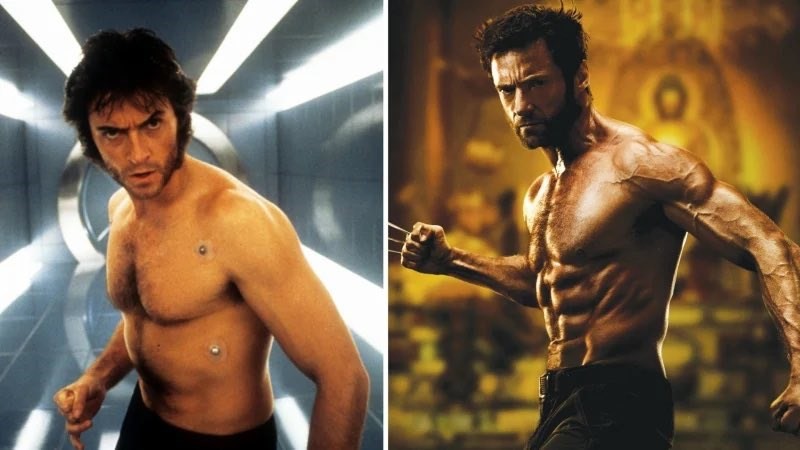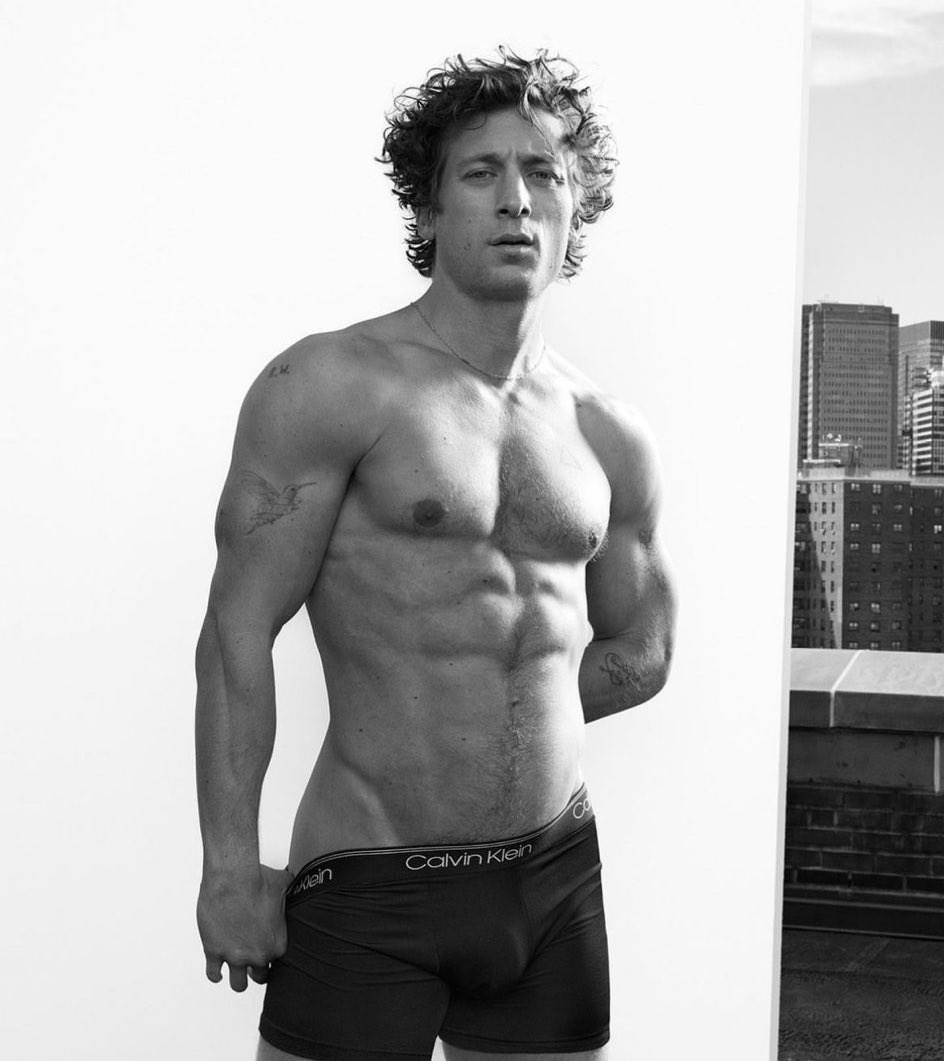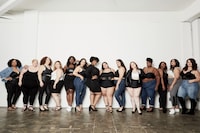We’re only a month into 2024 but already Jeremy Allen White’s Calvin Klein campaign stands as one of the biggest pop culture moments of the year, allegedly earning the fashion brand $12.7 million in media impact value within the first 48 hours of its release. It has generated memes, red carpet talking points – albeit often uninvited – and a lot of online discourse surrounding male body image.
While Calvin Klein has always used fairly buff models, it seems like physiques like White’s – once reserved for the likes of professional bodybuilders and fictional superheroes – are increasingly becoming the new normal. For many young men, it’s a case of the bigger the better. But the question is, does it really matter? Can men have whatever body they desire? Billie Eilish seems to think so, telling Variety last year that “nobody ever says a thing about men’s bodies. If you’re muscular, cool. If you’re not, cool. If you’re rail thin, cool. If you have a dad bod, cool. Everybody’s happy with it!” But is that really true? And if so, why are so many male bodies in mainstream media getting bigger and bulkier than ever before?
26-year-old Jake Kneeshaw – a PT and fit-fluencer, who has amassed over 150k followers on Instagram – feels that while working towards better health both physically and mentally is positive, we should be cautious of creating unrealistic expectations surrounding male physiques. His ethos is to promote self-love and body positivity, achieved through open and honest conversations about his own personal body image journey, and his Instagram helps young men with varying body types to feel seen. Despite his positive approach, he has been met with backlash in his comments and DMs. “The massive rise in the trend of bodybuilding is huge. Everyone and their cat wants to be a fit-fluencer at the moment, so it’s a really big industry and it’s super mainstream on social media,” he says.
It’s social media that is driving this pressure to achieve a physique that only a small percentage of the population actually have, as well as so much of the pop culture we are consuming right now. Over the past decade, the popularity of movies produced by Marvel has grown substantially, sparking TV spin-offs and making overnight superstars of their actors. The physical form of their male heroes is also at its biggest, with the likes of Chris Pratt, Chris Evans and Chris Hemsworth adhering to intense workout routines and having on-set chefs and personal trainers to ensure that they maintain their Gargarean physiques.
You can chart the changing bodies of Marvel heroes by looking at someone like Hugh Jackman and his body transformation over the past two decades as Wolverine. Between 2000’s X-Men, 2013’s The Wolverine and 2017’s Logan, his body gets increasingly bulkier, a potential nod towards changing standards of male body image in, and out, of the film industry. These bodies are not sustainable or even healthy – muscle definition is often achieved through dehydration – and many actors have spoken out against the process they had to undergo to achieve the look, from Paul Rudd to Channing Tatum. But when you have a predominantly young male fanbase, it goes without saying that many will want to replicate the bodies of their favourite superheroes, so it comes as no surprise that we’re seeing the everyday Wolverine in our local Tesco’s.
“I remember growing up watching Taylor Lautner in Twilight, and to look like Taylor Lautner would have been a dream,” Kneeshaw says. “Now I genuinely think that if you put a picture of him up on screen, most young men would be like ‘Nah, mid. He’s skinny’. Everyone wants to look like Chris Hemsworth as Thor. Nowadays, we are so far into this unrealistic expectation that our bodies are going to be sculpted by gods, which can be really unhealthy mentally.”

In 2023, Lautner himself spoke about the impact that the hysteria surrounding his body image had on him and his mental health in the years after Twilight concluded. On his podcast The Squeeze, he said that during the films he had to work “very hard for it” and “very, very hard just to maintain it”. When the Twilight saga ended and he started playing other roles, mainstream media and people online critiqued him for his changing figure. “They put the side-by-sides of me shirtless in the ocean in a scene from that movie compared to me in Eclipse or whatever and being like, ‘Wow, he’s let it all go.’ I was like, ‘Oh, man. Did I really let it all go?’ I didn’t think I looked that bad.”
Young men are also consuming another medium that is warping their body image: porn. The average age that most young boys first come into contact with porn is now just 11 years old, and a recent study found that large numbers of young people between the ages of 14 and 18 are consuming it regularly, with one in ten of those asked being addicted. In a similar way to how porn has influenced expectations surrounding women’s bodies, the same can be said for young men. Unrealistic bodies are seeping into our everyday conscience, especially for young boys who see ultra-muscular men in porn and may associate these bodies with sexual confidence and – to put it bluntly – the ability to get laid. Similarly, while sites like OnlyFans have offered the ability for a wider breadth of people to break into the porn industry, the most followed accounts are usually the ones featuring muscular, bulkier performers, so to many young men, this body type equates to success, both in popularity and sexual attraction.
As many have pointed out, a lot of body image pressure comes from other men. Many popular fit-fluencer’s Instagram comments are filled with other high-profile fitness personalities challenging them to be bigger, or criticising their current physique, which pushes them to go further, spurring their followers to do the same. On platforms like Reddit and 4chan, users share looksmaxxing tips (from mewing and mogging to “bone-smashing”), often rooted in incel culture, to help each other become “alpha” males. It can be a vicious cycle, especially in a society where so many young and impressionable men are constantly fed fitness accounts via Instagram and TikTok. There have been calls for better regulation on social media for misleading fitness accounts, but so far no such rules or regulations have been brought forward.
Max Swindells is a personal trainer from West Yorkshire. He’s 5 '11 and 92 kg with roughly 12-15 per cent body fat (for those unfamiliar with fitness metrics, he simplifies his physique by saying that he’s “often called an upside down Dorito”). He’s been running his business for over a decade, but started his fitness journey when lifting sandbags with his older brother in his family garage. “I was an aspiring footballer at the time and I needed to increase my strength. I soon saw the changes it made in my body – both from a performance and visual point of view. I’d be lying if I also didn’t do it for ego purposes to impress girls, ironically it’s rarely the girls that are impressed, it’s actually the guys!”
Footballers also have a part to play in their influence on male body image. Whilst the regular activity and intensity of their training means they tend to stay lean, key footballing figures like Cristiano Ronaldo, the most followed person on Instagram with 618 million followers, has continued to showcase his gym progress over the years, even in the past inspiring his son to join him in the gym. While the celebration of his body is entirely innocent, it’s the understanding that young men seeing these bodies regularly might encourage them to strive for the same – except without the team of professionals, money and technology.
Since starting his business ten years ago, Swindells has seen a shift in the fitness goals of the young men coming in to work with him. He says that the “new normal” is actually a physique that often takes years to achieve and is usually based on a photo of a fitness personality who is either post-comp or post-holiday prep. “It’s nearly always due to social media. This comparison is terrible for people’s mental health. I’ve noticed it a lot with younger clients. They often want to look a certain way that without years of training, the right genetics and PEDs [Performance Enhancing Drugs] is just not possible,” he says. “I try to educate as much as possible, so they’re not disappointed, however it’s a very fine line between having a pursuit that can be both very good for you mentally and physically but also terrible. Sadly, with the quality of coaching and social media, it’s more often the latter.”
It’s so crazy that in the 90s this is what “having a body” looked like, and now Marvel actors and regular degular guys alike are eating one cashew a day to attain a certain desirable body pic.twitter.com/BefYrer8DN
— Meech (@MediumSizeMeech) December 14, 2023
While working out can obviously have a positive impact on an individual’s body and mental health, at the same time it can often lead to an unhealthy relationship with body image. There’s a constant barrage of fitness content online, and for many young men, there’s no escaping it. This pressure is driving men to extreme lengths in order to achieve the new “ideal” body, as seen by the growing ‘muscle dysmorphia crisis’, a disorder where a preoccupation with one’s perceived lack of muscularity leads to dangerous behaviours like abusing pre-workout supplements, steroids and other PEDs, excessive exercise and restrictive eating.
You only have to take a quick scroll through the Instagram comments of a male fit-fluencer or body positivity activist to see that people have a lot to say about male bodies – and that pressure is ever building. The real question is what happens when your personal best becomes unbeatable, where do male bodies go from there? For Kneeshaw, he will continue to promote a healthy mindset towards working out and embracing your body. “Body positivity is so important to every individual, and it’s about showing yourself love and embracing the way you currently look instead of hating it, regardless of if you want it to change.”

